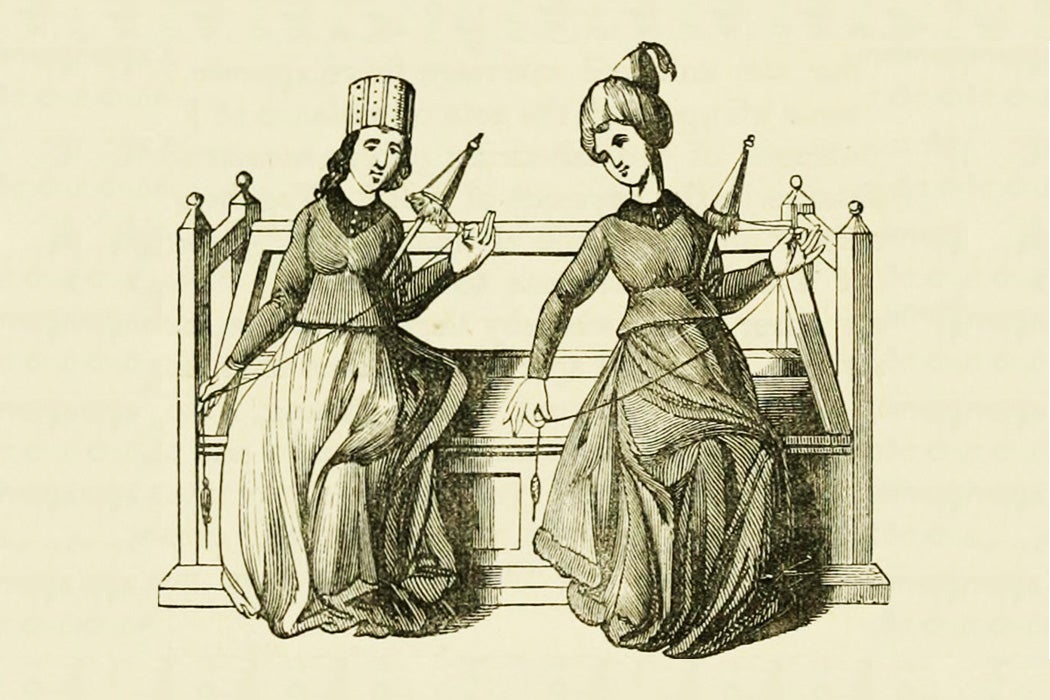Women’s paid work in medieval Europe was limited, to say the least. The options were essentially: domestic service, retail, midwifery, spinning, and sex work. None of these was considered skilled enough to be worthy of a guild. Guilds (also called gilds) were one of the most influential forms of organization and community in the Middle Ages. Organized around trades or crafts, guilds worked for the mutual benefit of their members. By controlling access to skills passed from master to apprentice, guilds could be a real economic and political force—and few of them allowed women members.
But there were some guilds for women. Historians Maryanne Kowaleski and Judith M. Bennett write that “the treatment of working women by medieval gilds is a complex and varied story.” Building on a historically significant article by one of the first women medievalists, Marian K. Dale, Kowaleski and Bennett argue that “gild membership allowed women to participate in some form of community life that offered its members economic security, spiritual comfort and social privilege.” Wives and daughters of male guild members, as well as widows of male members, were the most common female guild members.
On the other hand, Kowaleski and Bennett note, guilds did tend to treat women as second-class workers and members. There were “very, very few gild mistresses.”
Dale’s pioneering study focused on the “Sylkewymmen” of fifteenth century London. She wrote:
The industry of the silkwomen included three processes, and consisted of converting the raw silk into yarn [called throwing, hence a “throwster”], weaving the lesser silken materials (but not whole cloths), and making up goods.
These goods included ribbons and laces; cauls for the hair; points for silk laces; buttons, tassels, and fringes; cords for several purposes, including fastenings on clothing as well as decorative hangings from swords and seals of charters.
Such work was definitely recognized as skilled. And these women workers were organized enough to be some of the first to petition Parliament for protection against foreign competition, in 1455. But they never organized as a guild, writes Dale, even though they had a “mistery,” or body of knowledge shared by mistress to apprentice.
As Kowaleski and Bennett update Dale, however, they note “The absence of gild organizations among the London silkworkers is typical; in most medieval towns and cities, even the most skilled female trades and crafts never formed gilds.” The few exceptions were in Rouen, Paris (seven guilds in the late thirteenth century were exclusively female or female dominated), and Cologne.
Get Our Newsletter
Kowalkeski and Bennett summarize several theories for why the London silkwomen never formed a guild: patriarchal notions that women belonged in the home as mothers; women’s fears of being dominated by men in gilds; women being trained to think of themselves as members of families, not workers. Whatever the reason, the failure to form a guild was “clearly devastating.” Men took over the silk business in London as the sixteenth century progressed, replacing the women workers. These men formed a guild to protect themselves.
Referring to Dale and other pioneer women medievalists, Kowaleski and Bennett write:
Since these women were themselves exercising new options and roles for women, they sought positive images of women in their research, emphasizing the strengths of medieval women’s lives rather than the restrictions. Today’s generations of feminist medievalists tend to view the same evidence in a different light, seeing more constraints than independence.







